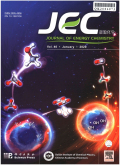- 钛学术文献服务平台 \
- 学术期刊 \
- 工业技术期刊 \
- 石油与天然气工业期刊 \
- 能源化学期刊 \
Structure evolution of oxygen removal from porous carbon for optimizing supercapacitor performance
Structure evolution of oxygen removal from porous carbon for optimizing supercapacitor performance
基本信息来源于合作网站,原文需代理用户跳转至来源网站获取
摘要:
The presence of oxygen functional groups is detrimental to the capacitive performance of porous carbon electrode in organic electrolyte.In this regards,hydrogen thermal reduction has been demonstrated ef-fective approach in removing the unstable surface oxygen while maintaining the high porosity of carbon matrix.However,the exact evolution mechanism of various oxygen species during this process,as well as the correlation with electrochemical properties,is still under development.Herein,biomass-based porous carbon is adopted as the model material to trace its structure evolution of oxygen removal under hydro-gen thermal reduction process with the temperature range of 400-800 ℃.The optimum microstructure with low oxygen content of 0.90% and proper pore size distribution was achieved at 700℃.XPS,TPR-MS and Boehm titration results indicate that the oxygen elimination undergoes three distinctive stages(intermolecular dehydration,hydrogenation and decomposition reactions).The optimum microstructure with low oxygen content of 0.90% and proper pore size distribution was achieved at 700 ℃.Benefiting from the stable electrochemical interface and the optimized porous structure,the as-obtained HAC-700 exhibit significantly suppressed self-discharge and leak current,with improved cycling stability,which is attributable to the stabilization of electrochemical interface between carbon surface and electrolyte.The result provides insights for rational design of surface chemistry for high-performance carbon electrode towards advanced energy storage.

推荐文章
Identification of terrigenous and autochthonous organic carbon in sediment cores from cascade reserv
Cascade reservoirs
Terrigenous OC
Lignin
Autochthonous OC
Three-end-member mixing model
Carbon dioxide emissions from the Three Gorges Reservoir, China
CO2 emissions
Three Gorges Reservoir
River-type reservoir
Sources of dissolved inorganic carbon in rivers from the Changbaishan area, an active volcanic zone
Carbon isotopes
Dissolved inorganic carbon
Rivers
Chemical weathering
Changbaishan
Active volcanic zone
Antimony removal from wastewater by sulfate-reducing bacteria in a bench-scale upflow anaerobic pack
Antimony
Removal
Mechanism
Wastewater
Sulfate-reducing bacteria
内容分析
关键词云
关键词热度
相关文献总数
(/次)
(/年)
引文网络
引文网络
二级参考文献 (0)
共引文献 (0)
参考文献 (0)
节点文献
引证文献 (0)
同被引文献 (0)
二级引证文献 (0)
2020(0)
- 参考文献(0)
- 二级参考文献(0)
- 引证文献(0)
- 二级引证文献(0)
引文网络交叉学科
相关学者/机构
期刊影响力
能源化学
主办单位:
中国科学院大连化学物理研究所
中国科学院成都有机化学研究所
出版周期:
双月刊
ISSN:
2095-4956
CN:
10-1287/O6
开本:
出版地:
大连市中山路457号
邮发代号:
创刊时间:
语种:
eng
出版文献量(篇)
2804
总下载数(次)
0
总被引数(次)
7996
期刊文献
相关文献
推荐文献
- 期刊分类
- 期刊(年)
- 期刊(期)
- 期刊推荐
一般工业技术
交通运输
军事科技
冶金工业
动力工程
化学工业
原子能技术
大学学报
建筑科学
无线电电子学与电信技术
机械与仪表工业
水利工程
环境科学与安全科学
电工技术
石油与天然气工业
矿业工程
自动化技术与计算机技术
航空航天
轻工业与手工业
金属学与金属工艺
能源化学2022
能源化学2021
能源化学2020
能源化学2019
能源化学2018
能源化学2017
能源化学2016
能源化学2015
能源化学2014
能源化学2013
能源化学2012
能源化学2011
能源化学2010
能源化学2009
能源化学2008
能源化学2007
能源化学2006
能源化学2005
能源化学2004
能源化学2003
能源化学2002
能源化学2001
能源化学2020年第9期
能源化学2020年第8期
能源化学2020年第7期
能源化学2020年第6期
能源化学2020年第5期
能源化学2020年第4期
能源化学2020年第3期
能源化学2020年第12期
能源化学2020年第11期
能源化学2020年第10期
能源化学2020年第1期

 免费查重
免费查重










